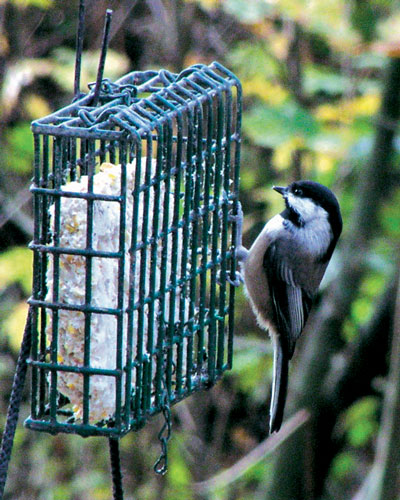The Urban Home & Garden
Welcoming birds to your yard, garden or deck
December 2011
Welcoming birds to your yard, garden or deck
December 2011

Wild birds flock to birdfeeders year round (Photo: C&S Products Co.)
TYPES OF FEEDERS
· Tube feeders are easy to fill and hang, and they hold quite a bit of seed.
· Platform feeders are generally constructed of wood. They tend to waste significant amounts of seed due to theft by squirrels and other predators. However, they are excellent for attracting birds that do not readily visit perch feeders.
· House or hopper-type feeders may be constructed of wood, plastic or glass. Bigger models hold large quantities of seed and allow several birds to perch at once.
· Window feeders are usually plastic and contain a suction cup for easy mounting to windows. Birds have a tendency to crash into windows if they are too clear, so care must be taken if using this type of feeder!
· Suet and fruit basket feeders are generally made of plastic-coated wire and can accommodate anything from a single suet cake to fruit or bread. A suet cake is made of a blend of seeds, nuts, fruits, and fat nutritionally balanced to provide wild birds with much needed energy. Suet nets or “thistle socks” are for feeding Nyjer thistle to finches.
· Hummingbird feeders contain a delivery system of nectar or sweet liquids for hummingbirds and fruit-loving birds. Hummingbird nectar is available in both a liquid and powder concentrate or an easy nectar mixture can be made by mixing one part sugar to four parts boiling water. Nectar should be changed every three to five days to avoid spoilage or mold growth.
LOCATION, LOCATION, LOCATION
Some birds may never come to a feeder if it is too close to a building or makes them sitting targets for predators. Keep feeders about 15 feet away from shrubbery, overhanging limbs, or other hiding places. Do our feathered friends a favor and put a bell on cats that are used to being outside.
Also make sure that rodents aren’t using your birdfeeder as a fast-food outlet, as most bird food is also very attractive to mice and rats. Store extra feed in sealed, rodent-proof containers; fill birdfeeders over a basin that can be cleaned out when you’re finished; and keep the area around and under the feeder as clean as possible – using a seed catcher will help keep loose seed from collecting around the base of your feeder.
For year-round feeding, black-oil sunflower seed is a good option as the shell is relatively thin, making it easy for birds to handle. These sunflower seeds also have a high meat-to-shell ratio with a high fat content that birds need. Usually a variety of ingredients is added to these mixes to attract many different types of colorful birds. Added vitamins and minerals help wild birds through the winter season.
Birds also need water for drinking and feeding, but they don’t require an elaborate or ornate birdbath. Some water in a shallow dish with a few twigs or branches strewn across the dish for the birds to perch on will do just fine. Water should be kept fresh and changed daily if possible.
Julia Strzesieski is the marketing coordinator at Cole Hardware. E-mail: julia@
colehardware.com


